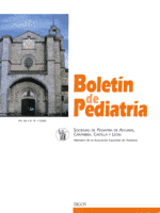Neurofibromatosis tipo I (von Recklinghausen). A propósito de una casuística pediátrica
R. Palencia , R. Nieto , P. Bahillo , Mª. Blanco , Mª. Escorial
Bol. Pediatr. 2002; 42 (181): 201 - 207
Objetivos. Analizar la clínica y radiología de pacientes pediátricos afectos de NF 1. Pacientes y métodos. Se estudian 33 pacientes diagnosticados de NF1 según los criterios del NIH. Resultados. Existe predominio - no significativo- de las mujeres. 28 pacientes (85%) presentan antecedentes familiares. Las manchas color café con leche son de presentación constante, asociadas a efélides en el 48,5% . El 36,4% presentaban fibromas, que eran plexiformes en el 15,5%; la escoliosis se observó en el 33,3% y el 3% mostraban pseudoartrosis y una hemihipertrofia facial. El 9% tenía retraso psicomotor, el 30% cefalea, el 9% crisis convulsivas, el 6% hiperactividad y el 3% temblor. La presencia de tumores se evidenció en el 12% y de UBOs en el 45% de los casos estudiados con RM. Conclusiones. La NF1 afecta a todos los órganos y, por su carácter evolutivo, obliga a efectuar controles periódicos. Las manchas de color café con leche son una manifestación constante, por lo que su presencia en un lactante debe alertar al pediatra para la búsqueda de otras manifestaciones de la enfermedad. La radiología mostró tumores intracraneales en el 12% de los pacientes y los UBOs se evidenciaron en el 45% de los que fueron estudiados con RM encefálica. Abstract Objectives. To examine clinical and radiological manifestations in a group of pediatric patients suffering from NF1. Patients and methods. Thirty-three patients with a diagnosis of NF1 according to NIH criteria underwent clinical and radiological assessments. Results. In this group, female patients predominate over male patients (difference non- significant). Twenty-eight patients (85%) had a positive family history ? 71% in the maternal line, 39% in the paternal line and 7% in both. Caféau-lait spots were present in every case (100%), associated with ephelides in 48.5% of the patients. Fibromas were present in 36.4% of the cases, being plexiform in 15.5%; scoliosis was observed in 33.3%, and 3% of the cases showed pseudoarthrosis and facial hemihypertrophy. Nine percent of patients had a psychomotor retardation, 30% headache, 9% seizures, 6% hyperactivity and 3% tremor. Brain neuroradiology allowed to detect the presence of tumors in 12% of the cases and UBOs (high signal intensity foci) in 45% of the cases studied with this technique; 2 patients had an arachnoidal cyst and 1 showed hydrocephaly. Conclusions. NF1 can affect all the organs and, due to its evolutive nature and the possibility of development of new manifestationes, periodical assessments are mandatory. Café-au-lait spots are a constant manifestation with an early onset; that is why, their presence in an infant should alert the pediatrician to search for other more relevant signs. Neuro-radiology showed intracranial tumors in 12% of our patients and UBOs were observed in 45% of those examined by brain RM.
\N
\N
Artículo completo (PDF) (91 kb.)
- Neurología
